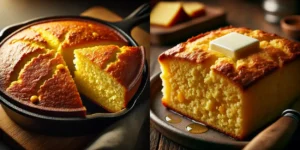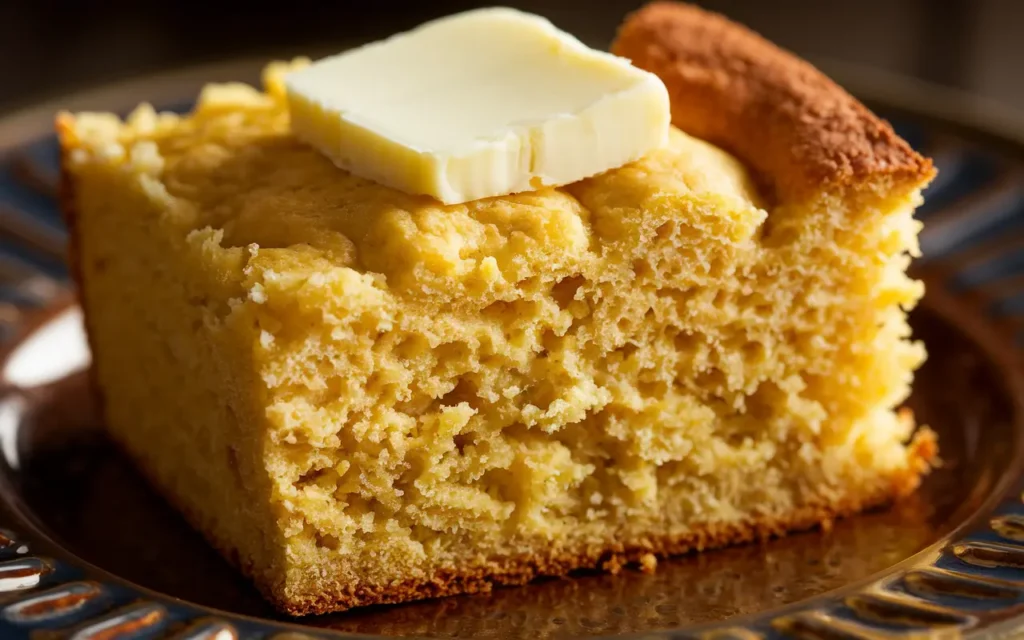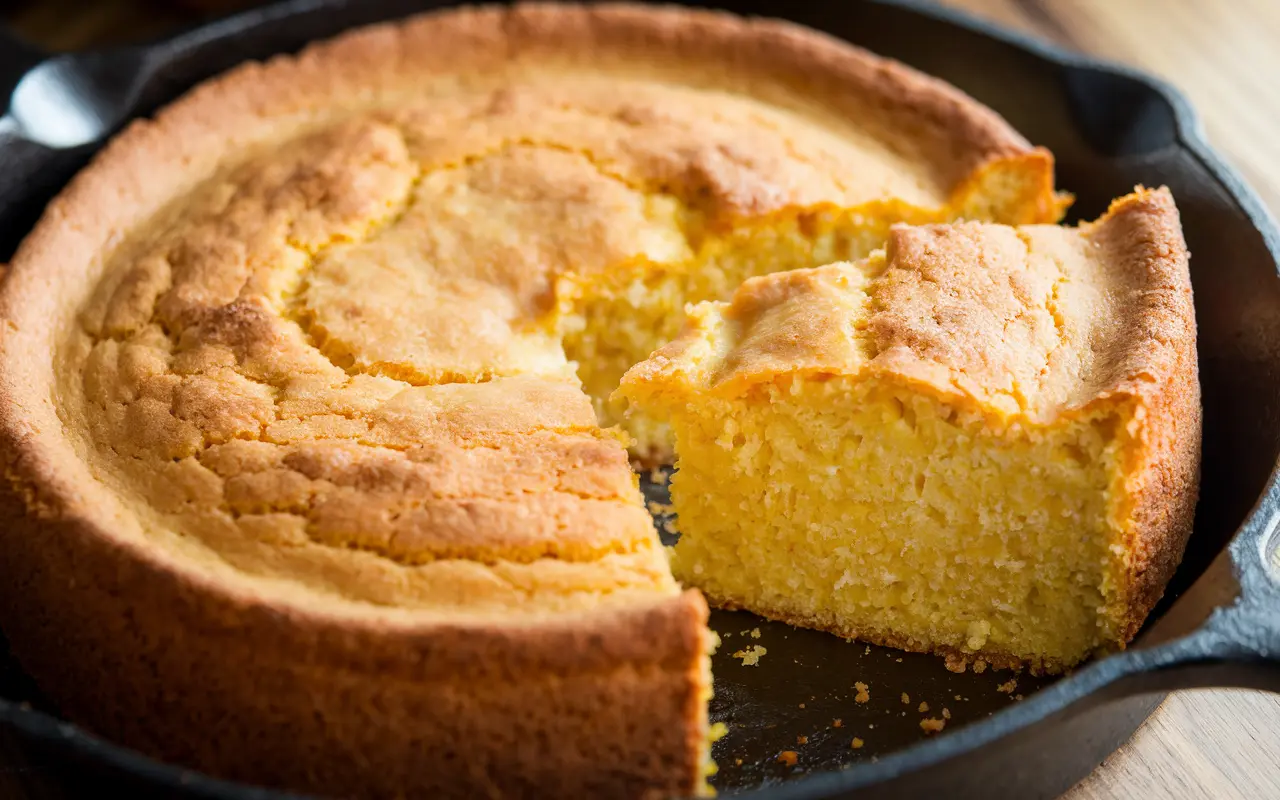Golden, buttery, and with just the right amount of crumbly texture, Grandma’s Cornbread is the heart of Southern comfort food. Whether served with a bowl of chili, a plate of barbecue, or simply slathered with butter and honey, this classic dish has graced American tables for generations.
But cornbread is more than just a side dish it’s a symbol of resilience, resourcefulness, and tradition. Its history dates back centuries, deeply intertwined with Native American cooking and the survival stories of early settlers.
So, what makes this old-fashioned cornbread recipe special? It’s simple yet rich, just like the memories of family dinners at Grandma’s house. Let’s dive into its fascinating history before uncovering the time-honored recipe that has been passed down for generations.
Table of Contents
The History of Cornbread
The Native American Origins
Long before European settlers arrived, Native American tribes were grinding corn into meal and using it to create simple bread-like foods. Known as ash cakes or johnnycakes, these early forms of cornbread were cooked over an open fire on hot stones or in clay pots. Corn, or maize, was a staple crop and provided a reliable food source that could be stored for long periods.
When settlers from Europe arrived in the Americas, they quickly adopted corn as a crucial ingredient in their diets. Unlike wheat, which was difficult to grow in the Southern climate, corn thrived, making cornbread an essential part of daily meals.

Cornbread in the South: A Food of Survival and Comfort
By the 1800s, cornbread had become a Southern staple, evolving from its simple origins into a more refined dish. It was especially popular among farmers and working-class families because it was affordable, filling, and easy to make with just a few basic ingredients: cornmeal, water (later replaced by milk or buttermilk), eggs, and fat.
During the Civil War, cornbread became even more important, as wheat flour was scarce, and Southern households relied heavily on cornmeal-based recipes. Soldiers carried cornmeal rations, which they mixed with water and cooked into makeshift bread over campfires.
As the decades passed, families refined their cornbread recipes, adding butter, sugar, or even bacon grease to enhance its flavor. Some preferred it sweet and cake-like, while others kept it savory and dense, perfect for soaking up Southern Biscuits and Gravy or a hearty stew.
Grandma’s Cornbread Recipe
This traditional Southern cornbread is baked in a cast-iron skillet for a crispy golden crust and a tender, buttery interior. No fancy ingredients just the same simple, hearty flavors that have stood the test of time.
Ingredients
- 1 cup cornmeal
- 1 cup all-purpose flour
- ¼ cup granulated sugar (optional, for a slightly sweet version)
- 1 tbsp baking powder
- ½ tsp salt
- 1 cup buttermilk
- 2 large eggs
- ¼ cup melted butter
- ¼ cup vegetable oil

Instructions
- Preheat the oven to 400°F (200°C). Grease a cast-iron skillet or an 8-inch baking dish with butter or oil.
- Combine dry ingredients in a large mixing bowl: cornmeal, flour, sugar, baking powder, and salt.
- Mix wet ingredients in a separate bowl: buttermilk, eggs, melted butter, and vegetable oil.
- Combine wet and dry ingredients, stirring until just incorporated (do not overmix).
- Pour the batter into the greased skillet and smooth the top.
- Bake for 18-20 minutes or until golden brown and a toothpick inserted in the center comes out clean.
- Let cool slightly before slicing. Serve warm with butter, honey, or alongside Grandma’s Meatloaf for a complete meal.
Grandma’s Secrets: Tips & Variations
How to Get the Perfect Texture
- For a crispier crust, preheat the cast-iron skillet in the oven before pouring in the batter.
- For extra moist cornbread, add an extra tablespoon of butter or a dollop of sour cream to the batter.
- Want fluffier cornbread? Use cake flour instead of all-purpose flour for a softer texture.
Classic Variations
- Savory cornbread: Omit the sugar and mix in chopped jalapeños, shredded cheese, or crumbled cooked sausage.
- Sweet cornbread: Increase the sugar to ½ cup and add a touch of vanilla extract.
- Buttermilk cornbread: If you don’t have buttermilk, mix 1 cup of milk with 1 tbsp of vinegar and let it sit for 5 minutes before using.
Grandma’s Biggest Rule
“Never cut cornbread straight out of the oven!” Grandma always said it needed to rest for at least 10 minutes so the flavors could settle and the texture wouldn’t fall apart.
More Than Just a Side Dish
Cornbread isn’t just food it’s a symbol of heritage and community. Whether served at a family barbecue, a holiday feast, or simply with a bowl of homemade soup, it carries the warmth of generations past.
Each family has its own twist on cornbread, passed down through stories, flavors, and traditions. Some like it sweet, others prefer it savory but one thing remains the same: the love and memories baked into every bite.
For another classic Southern dish that pairs well with cornbread, check out Chicken and Dressing a beloved holiday favorite that makes great use of leftover cornbread!
What’s Your Cornbread Story?
Did your grandmother have a special way of making cornbread? Share your favorite cornbread memory in the comments below!

